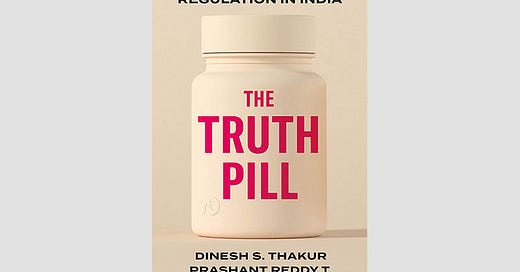BOOK REVIEW: The Truth Pill (The Myth of Drug Regulation in India)
By Dinesh S. Thakur and Prashant Reddy. Simon & Shuster India, hard cover. 512pp, Rs899
By: Majid Maqbool
The question of how safe and effective are drugs manufactured in India should be a critical public health issue both in the country and internationally as cheap products are increasingly sold across the world, particularly in Africa. Yet, it isn’t as successive government have over the years have failed to improve the quality and mechanism of drug regulation. The sale of medicinal drugs, at a time when India brands itself as the “developing world’s pharmacy,” remains largely unregulated.
Many of these drugs have found their way to Indonesia, where in October, the Indonesian Ministry of Health reported that acute kidney disease cases had affected at least 241 victims across 22 provinces as of October 21, including 133 dead. The number of cases tripled in three months.
The Indonesian situation bears a striking resemblance to one in the Central African nation of Gambia, where at least 66 children suffered acute kidney damage and died after consuming syrups made by the Indian company Maiden Pharmaceuticals. The World Health Organization (WHO) recently announced that Maiden may be responsible, saying that diethylene glycol (DEG) has been found in four syrups produced by the company.
What are the reforms needed for better drug regulation and how can the Indian pharmaceutical industry be held accountable for their wrongs and failures to ensure better quality of ‘made in India’ drugs? These and many other issues affecting India’s drug regulatory mechanism and pharmaceutical industry are explored in detail by Ranbaxy whistle-blower Dinesh S. Thakur and lawyer Prashant Reddy T. in their recently published book, The Truth Pill: The Myth of Drug Regulation in India.
There have been at least five major DEG poisonings in India itself – most recent in December 2019 when 11 children from Ramnager Jammu, in the Jammu and Kashmir region died due to renal failure from DEG poisoning after taking a cough syrup made by a pharmaceutical company whose manufacturing base is in Himachal Pradesh. The company is yet to be prosecuted or held accountable for the deaths of these children more than two years after the incident. The authors argue that such tragic incidents occur because pharmaceutical companies quite often fail to either test the raw materials or the final formulations before shipping them to the market.
The lapses in drug inspection in the country are also examined in detail in the book. The authors point out flaws and discrepancies in drug inspection across states and failures to recall drugs from the market that are found to be of substandard quality and hence unfit for consumption. The drug inspectors, the authors point out, are still drawing samples from the open market for testing, and pharmaceutical companies often fail to test either the raw material or the final formulation before shipping it to market. The pharmaceutical company whose cough syrup caused the deaths in Jammu had failed quality tests on 19 previous occasions.
The book also highlights other problems such as unhygienic conditions, impure water, open drains and other cleanliness issues plaguing pharmaceutical manufacturing units across the country which have remained unaddressed. United States Food and Drug Administration (USFDA) inspectors, the book notes, came across “bird infestations at a sterile manufacturing plant, bathrooms with pools of urine on the floor, gloves designated for use in sterile areas that were flaking, crushed insects in a shipping box for gloves, failure to maintain records of sterilization, and in one instance, a snake coiled on laboratory equipment!”
Although the West has blocked export of “Made in India” drugs manufactured by many Indian pharmaceutical companies, the Indian government has rarely enforced tighter regulatory reforms as an effective response and instead dismissed such concerns and questions on drug quality as “conspiracy theories” by “vested interests” working against India. In addition, the Indian pharmaceutical industry has over the years applied less rigorous standards to drugs that are exported to poorly regulated markets, in Africa, for example.
The book raises crucial questions around drug regulation in India today while also suggesting reforms for better regulation and ensuring quality medicines in the market. The authors call for a need to have a more comprehensive and clearer public health policy which prioritizes public health over profits of the pharmaceutical industry. The book also explains shortcoming of drug regulatory mechanism in the country and inspections at the central and state government level, calling for a need to centralize at least the licensing aspect of drug regulation. The authors also call for a better focused health activism in the country, presently missing, to apply much needed pressure to the government and help improve the quality of drug regulation in the country.
Overall, the book is a comprehensive and revealing account of shortcomings and various flaws in drug regulation in India and the urgent need to fix it for better public health which, the authors emphasize, should be the front and center of regulatory policies.



